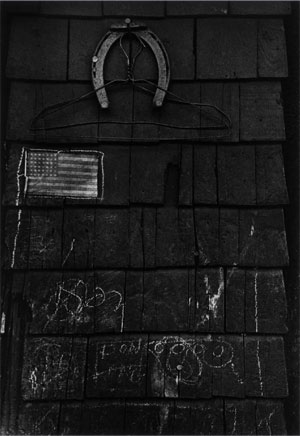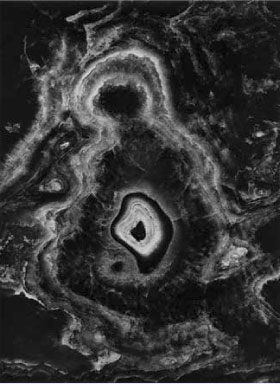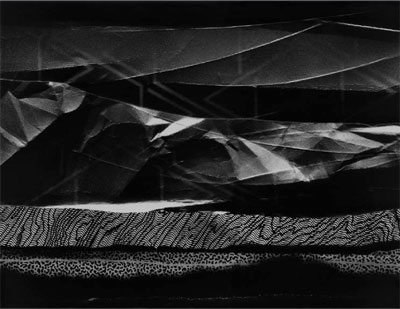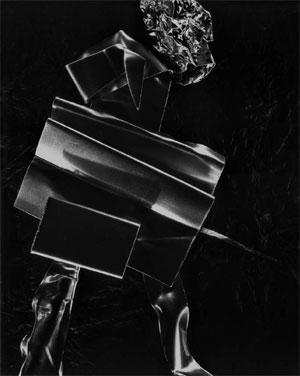|
|
|
 |
 |
 |
 |

"Carl Chiarenza: Internal Landscapes,"
Photo Review, V. 28, No. 4, 2009, pages 2 – 6.
By Robert Hirsch
 |

Carl Chiarenza: Interaction — Locomotive #6, 1957
|
Robert Hirsch: How has your family background shaped your life?
Carl Chiarenza: I was born in Rochester, New York. My parents were immigrants from Italy. During the Great Depression my father could be found in breadlines when he wasn't a laborer for the WPA. He was an amateur neoclassical painter and sometime woodcarver who worked in factories when he could. In the 1930s and 1940s he was a communist. Following that difficult period he supported the family as a cabinetmaker working for companies producing display units. My mother worked as a seamstress in the Rochester clothing industry. Along with art, music of all kinds was big in our house. We listened to popular Italian and American songs and opera every Saturday. My father played the mandolin and played music with relatives on banjos and guitars. My three brothers and I all sang, played musical instruments, and drew. I don't do anything without music.
RH: I've noticed you have music in your studio and darkroom.
CC: Everywhere. I don't work without it. I started playing the clarinet in grammar school and studied with a graduate student at the Eastman School of Music. I played in the school bands and orchestras and sang in the choirs. I paid my way through Rochester Institute of Technology playing jazz (tenor sax and clarinet) with the Johnny Matt Band and working in the local bakery as well as jewelry and photo shops.
RH: How does music affect your picture making?
CC: I struggle to do with pictures what composers do with music — make that indefinable, emotional contact.
RH: How do you utilize music in your work?
CC: For example, while making the images for my book, Solitudes (Lodima Press), I listened over and over to pianist Mitsuko Uchida playing Mozart's sonatas because they put me into a spectacular solitary place, which pervades the studio and hopefully influences the work. And that is continued in the darkroom in the making of prints.
RH: What role did religion play in your upbringing?
CC: My father, like most other Sicilian laborers, was raised as a Catholic. I recently found out my dad was molested by a priest when he was an altar boy in Italy. I suspect that's part of the reason he withdrew from the church and was very much against it — and probably influenced his later interest in Marxism. On the other hand, my mother was a card-carrying Catholic while my father was a card-carrying communist. So, you might say, I had a mixed religious heritage [laughter].
RH: How did this affect your formal spiritual life?
CC: I stopped attending religious instruction when I was about twelve. A priest came to our house to find out why. My father answered the door and the priest noticed three of my father's paintings, all of which have nudes in them. The priest said, "Now I understand why your son is not coming to religious instruction." My father pushed him out the door and said, "Don't ever come back to this house again." I have often been caught saying that most of the problems in the world are caused by organized religion. They preach one thing and do something else. I believe there is something out there that is important as a force. I confess that I don't understand it. I keep searching for it since it certainly motivates me, and my work, but as far as organized religion is concerned, I'm not able to participate.
RH: How did you get interested in photography?
CC: The playground across the street from our house had a meeting and storage shack. The playground director was interested in photography and built a tiny darkroom in that shack. I was about eight years old; I had a Brownie camera and made my first pictures of neighborhood kids playing ball. Once I developed film in our second floor bathroom. I put the film tank in the bathroom sink to wash. I set the water at a trickle and went to the playground. When I returned water had flooded through the ceiling and into the first floor, almost ending my photographic career before it began. In high school I took a course on photography, was the newspaper and yearbook photographer, and built a darkroom in our attic, which was a perfect dream.
My father's brother built my first enlarger out of wood and an old camera. He also got me a 3-1⁄4" x 4-1⁄4" Speed Graphic camera, which I used throughout high school. My first serious picture was from a wall in one of the towers of East High School on graduation day 1953. People scribbled their names on that wall over the years. It was essentially my first abstract picture.
RH: Why did you go to the Rochester Institute of Technology (RIT)?
 |

Marble Madonna, Ipswitch, 1960
|
CC: I went to RIT because I was passionate about photography. I had no idea of becoming a photo artist. In my mind going to RIT for two years would lead to a good job at Kodak. At the end of the second year, Ralph Hattersley formed a new Bachelor of Fine Art program in photography, which enticed me and such fellow students as Pete Turner, Jerry Uelsmann, Ken Josephson, and Peter Bunnell. Minor White was hired to teach in that program. We had an incredible experience with these two crazy people: Ralph and Minor, who were creatively amazing and complete opposites!
RH: What did you learn from Minor White?
CC: Minor taught me to spend time looking deeply into pictures, from edge to edge. One consequence is that I am very critical of pictures because I see all the parts. He also made it clear we could make photographs with a passion that could be conveyed to others, you could be a poet with imagery or musician with imagery. Minor made me understand I could take my poetic inclinations and musical background and put this into a photograph that was as significant as any other form of expression.
RH: What did Ralph Hattersley teach you?
CC: The way I work today, making pictures out of what is essentially trash, has a great deal to do with Ralph Hattersley. Ralph spent his life stretching people and making them try to understand themselves. And he did it in ways completely opposite from Minor. He would say, "Go in the darkroom and look through the trash nd see if there is something there that you can reconstruct" or "put the print into the wrong chemistry and see what happens." Instead of talking about known structures, like the Zone System, and making beautiful prints, Ralph said, "Screw it up and see what happens." He encouraged us to try something different, while maintaining self-awareness. An emphasis on consciousness was the thing Minor and Ralph shared; yet they pursued it in independent ways.
RH: What motivates your picture making?
CC: I've been making pictures so long it's like eating. It's what I do everyday. I've always been interested in producing something, whether it's imagery, writing, or music, which gives back something of what I took in.
RH: What was the defining moment that guided you into the studio?
CC: In 1979 I was invited to use the new Polaroid 20x24 camera. I had no idea what the hell I was going to do. I wasn't used to bringing things to the camera or working in color. I spent day after day bringing stuff from home trying to make abstract still lifes and I failed. This led me to work at home with 4x5 Polacolor material. I finally came up with an Ansel Adams-style landscape made out of blue pieces of paper. I was making a monochromatic color picture, which made it clear to me I was a black-and-white photographer, not a color photographer. I got excited about being able to make this picture and I started making more landscape pictures at home. I found this approach much more conducive to making my kind of pictures so I stopped going outdoors. I also stopped using the 20"x24" Polaroid camera
[laughter].
RH: How did your notion of the landscape evolve from outside to inside?
CC: Once I stopped photographing outside I was no longer a part of actual nature. I went into the studio and made a series of pictures called Woods, which explored my feelings about nature along with my visual sense about nature in terms of picturing the landscape. I concluded that the idea of landscape is really a pictorial one. The word landscape didn't come into existence until pictures of nature were looked at and labeled landscapes. Previously people didn't refer to landscape out there. It became a landscape out there only after the picture was made. My sense of landscape, therefore, is that it is a pictorial idea that we construct. Along with the heat, the sun, and insects bothering me, nature is really completely apictorial, unruly, often ugly as hell and that's why you have to work so hard to make a photograph out there.
RH: How have photographers created a landscape genre?
CC: Landscape photographers, like painters before them, took from nature and then imposed their presence on it. Ansel Adams excelled at this. Ansel actually "made" Moonrise Over Hernandez, New Mexico in the darkroom. It was his visual idea, which he saw when he looked out into nature; and he knew he could make his vision happen by manipulating the light passing through the negative in the darkroom. Ansel made imaginary pictures based on his feeling about the landscape. It is a two-way street.
Humans bring their feelings to the landscape and the landscape in turn affects us. The picture is somewhere in between that, inspiration from the land, which itself is not making pictures or poems or music, but taking that raw material and reconstituting it into the feelings one associates with it.
When I make pictures in the studio, I take scraps of paper, play with them and with the lights directed upon them, and make what I would love to see in nature, but isn't there. I can't see it out there, but I feel it. It is my way of giving back to nature something that I got indirectly from nature.
RH: Why do you work in black-and-white?
CC: I am mildly colorblind, but I really don't think that is the cause. Fundamentally the kind of feeling and emotion I want to convey is best expressed in black-and-white. Color interferes and distracts from my objectives; it doesn't have that depth, that richness, that pulse, or as we would say in music, "that sound."
RH: What is the attraction in your prints to the photographic black?
CC: There is no other medium that has that quality. It slows you down. It forces you to stop and stay in the picture. We don't immediately make associations with the world in a direct way. Black and white connects you directly to your thoughts and feelings by reducing a subject to its essential qualities. It's not only the blacks, but also what happens with the light. It's really about light and the absence of light without the interference of those distracting colors. It's a conundrum.
RH: How do you utilize depth of field and sharpness?
CC: I was trained in the twentieth-century straight photographic tradition and it is a hard thing to buck. It's like a religion — you don't break the rules even though you try. I do break the rules, but primarily by doing the collages — a thing I learned from Hattersley - but, though I will occasionally use planes of relative focus for certain feelings, I still usually stop down to ƒ32 to get as much depth of field as possible.
RH: What is the key factor in your creative process?
CC: I go to work every day I can. The most important thing is just showing up.
RH: How would you describe your working process?
CC: I go into the studio and start with some pieces of paper that I left off with. It's like a writer saying don't go a day without writing a paragraph that you cannot start with the following day. I try to do that. It doesn't always work. Often I go in with nothing. It's really serendipitous. I go in there and I start pushing pieces of paper and other stuff around trying to make a collage. I may go in there with an idea as I did with for the theme books Solitudes or with The Peace Warriors, but normally I don't. Usually I start by moving stuff together and moving the lights around until something begins to develop and that gives me direction.
RH: How do you collect your materials?
CC: I pick up pieces of paper, and other small detritus, all of the time.
Sometimes people send me stuff. I just got a package of wonderful pieces of paper from a calligrapher who saw one of my presentations. A couple of my poker buddies bring me metal trash from their companies. Stuff comes from everywhere — the kitchen, pieces of metal from cans, foil off of wine bottles. I am always looking for new materials; it helps to break out of the ruts we all get into. Send me something!
 |

Tenaya 265, 1991
|
RH: Are you interested in collage as an independent art form?
CC: Yes, but not for my work. I am interested in experiencing work in all media and how those creative people use their media to move me. I admire work from Braque to Heartfield and Höch to Bearden to Joe Mills, but I have no interest in making collage as collage. My collages, as collages, are not very interesting. They only work as a means to photographs.
RH: How do you reconcile being an artist and making a living?
CC: When I started I never thought about making a living from my photographs, but today young people constantly ask me for advice on how to make it.
When I started, there was no "making it." I made pictures because I had to or wanted to. We all knew that making art with photography would not support us. We all found other ways to pay the rent. I tried journalism, ended up being an art historian. Now that I am retired from that role, I still try to stay with what is important to me, making pictures, and not getting too distracted by galleries, museums, and writing, but it's impossible to avoid, which is why I'm doing this interview with you [laughter].
My problem is not to be taken in by having to get the work out, shown, sold, and having people write about it. But I am human and I succumb. It is easy to lose track of what it is you are doing. Maintaining a balance among these areas is the tough thing to do. Nonetheless I still rarely make a profit at year's end.
RH: What is the connection between Landscapes of the Mind (1988) and your book Evocations (2002)?
CC: Landscapes of the Mind has pictures from the 1950s through 1986. Evocations has pictures from 1987 to 2000. Landscapes contains text and chronologies while Evocations is a poetic picture book (with poetry by Robert Koch) that is more abstract. Together, the two books survey my work, as opposed to three of the new ones which are thematic: The Peace Warriors of 2003 (Nazraeli Press, 2005), Solitudes (Lodima Press, 2005), and Interaction: Verbal/Visual (Nazraeli Press, 2007). The newest book (Pictures Come From Pictures, Selected Photographs 1955–2007, David R. Godine Publisher, Boston, 2008), however, surveys my work from 1955 through 2007 in a thematic form, which conveys recurring themes and forms over the years by juxtaposition or sequence.
RH: How does your book, The Peace Warriors of Two Thousand and Three (Nazraeli Press), differ from your previous ones?
CC: I was working in the studio listening to National Public Radio News about the war in Iraq and realized I was making a collage that looked like a warrior. I made pictures in the past called Don Quixote and Samurai. Since high school I have been attracted to the character Cervantes developed. Early in 2003 I made this one picture, and for the rest of the year I pursued the warrior idea, which is completely alien to the way I usually work. Although this work is certainly not social documentary, it is somehow connected to Iraq. These pictures are my response to the madness of the world. The samurai is one kind of warrior and Don Quixote is another kind of warrior; perhaps they are opposing each other. "Peace Warrior" is an oxymoron — but a meaningful one.
RH: How did Aaron Siskind affect your abstract photographic thinking?
CC: I was studying with Minor White and moving in the abstract direction before I met Siskind or saw his work.Around 1956 or 1957 Hattersley took our class to Chicago to meet Siskind Tenaya 265, 1991 and Harry Callahan at the Institute of Design. I was already interested in abstraction and its development in American art. I responded very positively to Siskind and his work. For me Aaron was a mensch, an honorable, down-to-earth man of integrity who could speak directly about issues without giving you a load of bullshit. We could talk and talk. He and his work gave me positive reinforcement for my direction. I loved the guy.
RH: How did Siskind's way of navigating the world affect you?
CC: Siskind had a great mind, was very conscious of the world, and was both a poet and an activist. Critics say his work, after he turned away from social documentary, had nothing to do with life and that his pictures did not help change the world. His mature work was not political in the sense of a direct response to immediate world events. It was about basic human conditions. Aaron's direct activism was done silently and quietly as a human being, not as a picture maker. That had a profound influence on me. He also protected me from hubris, from becoming artificial, arrogant, and prideful.
RH: How does this play in an era where photographers are expected to champion a cause?
 |

Peace Warrior (Don Quixote) 275, 2003
|
CC: Photography has a spread of possibilities far greater than any other medium. There have been photographers who have made amazing social documentary "pictures" that have been useful in changing society, but there are many ways of dealing with human beings and they're all important. It's not just the public disasters and man's physical (visible) inhumanity to man that need attention. There is another side to this story about humanity, dealing with love and friendship, with emotions and with invisible wounds, which we ought to be sharing. We need great picture makers in all aspects of photographic picture making.
One of the things that led Aaron to shift to abstraction, which I have written about (Aaron Siskind: Pleasures and Terrors, 1982) was that he felt his social documentary photography only affected the people already on that side of the arc.
I try to lead my life in terms of being helpful to the problems of the world by doing things quietly and privately, as Aaron did. My art is about something else, another "cause" that I feel is particularly important in our time. I am for everybody doing what he or she can do, the best way she or he can do it. If we don't have that balance, the world will be a sad place indeed.
This article is the result of numerous conversations and emails from June 2004 to January 2009.
© Robert Hirsch 2009.
For more information visit: www.carlchiarenza.com, www.nazraeli.com, www.godine.com, or www.lodimapress.com/html/carl_chiarenza.html.
Robert Hirsch's latest book is Light and Lens: Photography in the Digital Age. Also, new editions of Photographic Possibilities: The Expressive Use of Equipment, Ideas, Materials, and Processes and Seizing the Light: A Social History of Photography have just been released. His recent installation, World in a Jar: War & Trauma, has been touring internationally. For more information about his written and visual projects see www.lightresearch.net.
|
|
 |
 |
 |
 |
|
|
|